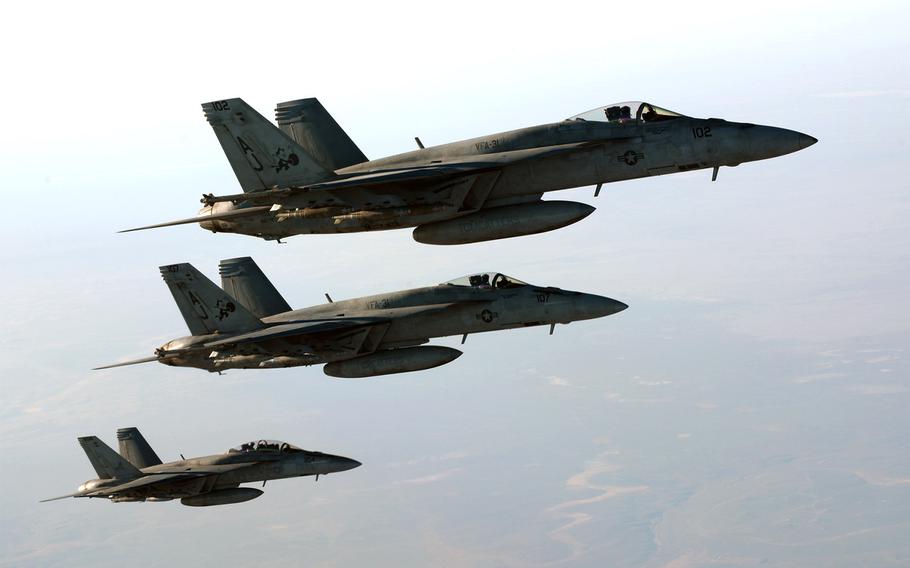U.S.
US, allies risk benefiting Syria's Assad by striking militants
Stars and Stripes September 24, 2014

U.S. Navy F-18E Super Hornets leave after receiving fuel from a KC-135 Stratotanker over northern Iraq, on Sept. 23, 2014. These aircraft were part of a large coalition strike package that was the first to strike Islamic State militant targets in Syria. (Shawn Nickel/U.S. Air Force)
WASHINGTON — One year ago, the Obama administration considered a cruise missile strike on Syria, but the target was not the Islamic State or al-Qaida.
The president accused Syrian President Bashar Assad of murdering more than 1,000 citizens with poison gas. But U.S. airstrikes never came. Instead, the U.S. opted to negotiate the removal of Syria’s chemical weapons, and Assad continued a bloody war against his opponents that has killed an estimated 200,000 Syrians over more than three years.
Administration officials said again this week that Assad must relinquish power. But the new U.S.-led air war there against the Islamic State and al-Qaida offshoots Khorasan and the Nusra Front puts the administration in a precarious position — it is counting on Assad’s ouster while pounding some of his most dangerous enemies from the air.
Islamic State and Nusra Front fighters in Syria are among the most effective opposition forces battling a regime that Washington opposes. The U.S. plan to arm and train moderate rebels is still in its infancy. Aircraft and missile strikes against Islamist fighters and facilities in the north runs the risk of strengthening Assad in his fight to hold on to power.
“You can’t say it doesn’t help the regime in some ways,” said Jeffrey White, a defense analyst at the Washington Institute for Near East Policy.
The strikes could free the Assad regime to turn its military power, which includes a sizable air force, on other opposition rebel groups in Syria that the U.S. supports, White said.
“You’re talking about attacking two of the most capable military forces that are opposing [Assad] — ISIL and the Nusra Front,” said Frederic Wehrey, a Middle East analyst with the Carnegie Endowment for International Peace, who used an alternate acronym for the Islamic State. “You could certainly make that argument that when you intervene in one side and not the other you’re implicitly backing one side.”
President Barack Obama said this week the administration will begin offering weapons and training to moderate anti-Assad militias fighting both the government and the Islamic State. Congress quickly approved the effort this month but set a deadline of Dec. 11 for the program to expire.
In the meantime, the U.S. air campaign has struck about two dozen militant targets inside Syria.
Most of those targets have been associated with the Islamic State, a group of about 30,000 fighters that flourished while fighting the Assad regime in Syria and now imposes brutal Islamic rule in wide swaths of that country and Iraq.
As analysts sorted through the rubble and satellite images, information on the extent of the strikes was still coming out Wednesday. The Pentagon claimed they were highly effective.
With the war against the Islamic State and the air campaign in Syria likely to continue for years, the effects on the Assad might not be known for some time, said Anthony Cordesman, who holds the the Arleigh A. Burke chair in strategy at the Center for Strategic and International Studies in Washington, D.C.
“It is far too early to even begin to answer that question,” Cordesman said.
Assad had controlled a population of about 22 million, though millions have been displaced or left the country because of the fighting, and more than 70 rebel factions are in open revolt against his government in Damascus, he said.
“It is not clear that weakening the worst of the rebels is going to strengthen Assad,” he said.
Michael O’Hanlon, a senior foreign policy fellow at the Center for 21st Century Security and Intelligence, said the U.S.-led airstrikes against the Islamic State or other the al-Qaida groups so far have not been extensive enough to create a power vacuum that could be filled by Assad — or moderate rebel groups that will be getting American support.
“I expect the effects to be more limited and localized,” he said.
O’Hanlon said he would be surprised if the strikes alone lead to a general collapse of the Islamic State or a major shift for the Assad regime.
“On balance, it’s not a huge deal,” he said.
tritten.travis@stripes.com Twitter: @Travis_Tritten
harper.jon@stripes.com Twitter: @JHarperStripes